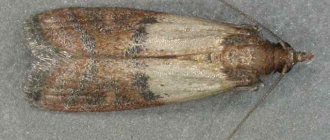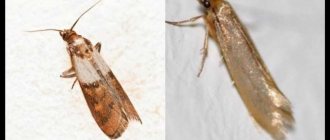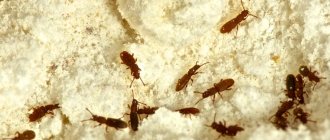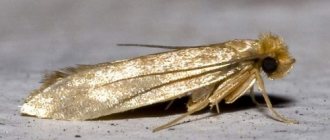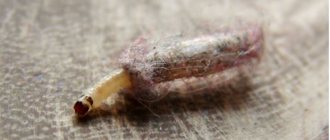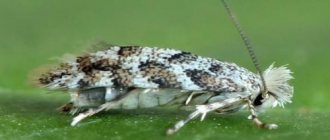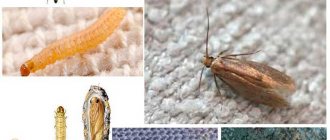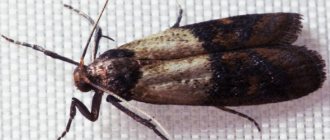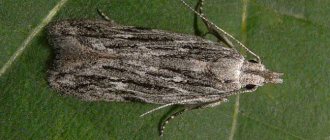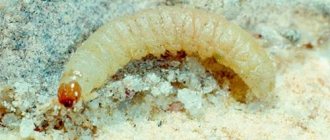A moth's lip is not stupid. She is not interested in cheap synthetics - give her fur. Silk and wool, natural and expensive, will also work. If she’s really hungry, she won’t disdain feathers and cotton. How to protect your most valuable things from an insatiable pest?
To win the war against clothes moths, you need to carefully study its preferences and find vulnerabilities, and then deprive it of pleasures and strike where it hurts the most. Only then will it be possible to get rid of the voracious insect once and for all.
Appearance of a moth larva
Everyone can imagine a small fruit worm, which is often found in apples or other fruits that have not been treated with pesticides. This will allow you to understand what a moth larva looks like.
Appearance of a moth larva
The pest caterpillar is pale yellow in color, has 12 limbs and a darker head. The length can be from 6 to 12 mm. Thickness no more than 2 mm.
Fruit caterpillars and moth larvae are similar in appearance, so the presence of pests in the house is easier to notice by flying silvery moths.
Prevention
To prevent the moth larva from actively destroying valuables or food, it is important to know how to prevent the pest from appearing in the house. To protect your home, it is important to follow a number of rules.
So, only washed items should be stored in closets. From time to time, all woolen or fur products and natural fabrics must be ventilated in frost or sun.
Other rules of prevention:
- Fur and wool must be periodically treated with insecticides.
- Items cannot be placed in plastic bags.
- Herbs that repel parasites (tansy, wormwood, lavender) should be placed in the wardrobe and chest of drawers.
- You can place citrus peels in the kitchen.
- On shelves with clothes you need to place pieces of foam rubber soaked in essential extracts.
- All food products that can be damaged by larvae must be periodically sorted and stored in closed containers.
- Regularly you need to carefully inspect all seams and folds on things for the presence of parasites.
Microscopic larvae can ruin expensive and valuable things. Therefore, it is easier to prevent their occurrence than to purchase a new fur coat, furniture or carpet.
To do this, it is important to follow the prevention rules described above. And at the first sign of moths appearing in the house, carry out a thorough disinfection.
Type of moth
The insect belongs to the butterfly family. About 30 different species of moths are known, half of which are capable of living at home.
Based on the type of feeding preferences, parasites can be divided into 2 groups: food and fur.
Food moth Coat moth butterfly
The most common household pests:
| Appearance of a moth | Clothes | Fur | Furniture | Barn |
| Color | Dark purple fading to beige | Light brown with black dots | Yellow with dark red | Silver gray |
| Wingspan | 20 mm | 15 mm | 10 mm | 15 mm |
| Power type | Natural and semi-synthetic fabrics, wool | Fur, natural materials | Upholstery | Bulk products (cereals, flour), dried fruits, groceries |
There are also several types of “vegetable” moths (cabbage, potato, wax moths), which appear in beds, gardens or apiaries, destroying green shoots and honeycombs. But these insects do not move into the home.
How they develop and reproduce
The development cycle is standard for this class of insects. Adults lay white or silvery microscopic eggs, from which small caterpillars emerge.
This phase of the moth's life is the most dangerous for fabrics and dry foods. During the growth process, the larva requires the maximum amount of food, and the structure of the insect's jaws allows it to process a large amount of material.
Breeding cycle
After the moths appear, their main function will only be reproduction.
Males die immediately after mating. Females end their lives after laying eggs, the number of which can reach several hundred.
Ways to fight
It will be quite difficult to get rid of moths, since they are resistant to changes in temperature outside. If knitted scarves, mittens, or sweaters are damaged, you need to decide whether it is worth restoring the item or whether it is better to throw it away. Because there may be eggs left in the clothes, lost between the seams, which can become a step in the emergence of new larvae.
Folk remedies alone will not be enough if the number of moths and damaged things is large. Professionals advise buying chemicals to treat damaged items. We need to understand that we must fight not with adults, but with their larvae.
Onion fly: effective means and methods of control
The main thing to remember is that the kitchen and damaged products should not be treated with chemicals. Therefore, spoiled porridges and cereals should be thrown away. Eating foods that contain moths is strictly prohibited. When cleaning the kitchen, you should use detergents with the addition of soda, as this product has good disinfecting ability.
What do moth larvae eat?
The consequences of the life activity of the house moth larvae look like a mixture of gnawed fabric, fur or dry foods mixed with a dusty substance.
Wool, fur, clothing and furniture insects feed on natural or mixed fibers, including some types of synthetics. The fur moth is capable of laying a path along its route, which will look like a shorn strip.
Moth eats fur coat
A smaller variety of furniture parasites immediately selects upholstery areas with a large amount of material for laying eggs, so that the hatched individual is provided with food from the moment of birth and cannot die. A hole appears in the place where furniture moths live.
Feeding individuals destroy the structure of grains and cereals, turning them into dusty mush, held together by the biological material of caterpillars and eggs.
Moth eats cereal
Who eats our clothes
The clothes moth (also known as the house moth) is a small butterfly with golden wings with fringed edges. However, she is not the main enemy of our things. Irreparable damage to the wardrobe is caused by its larva - a transparent white caterpillar up to 1 cm long. The caterpillar is very lazy, inactive, but when it needs to find food for itself, it begins to move.
When you see a moth flying around the house, you don’t even have to run after it, trying to swat it. The fact is that only males or females who have already laid eggs fly. They will no longer bring you harm, and they will soon die themselves. You need to hunt for their eggs and larvae.
How moths get into our houses and apartments
The easiest way is through an open window or door. However, clothes moths are also capable of entering a home through a narrow gap. The flying butterfly finds suitable conditions for reproduction and food and lays eggs there.
If you brought an antique or simply used sofa from somewhere, it is quite possible that there were already eggs or moth larvae in its upholstery. The same goes for used clothes.
Clothes moth larvae can come to us, although rarely, through the fur of domestic animals.
How to get rid of moth larvae
In order to effectively get rid of insects, you need to know their weaknesses. All varieties of moths will be afraid of bright light, strong odors, and large temperature changes (extreme cold or heat).
If colonies of insects have laid eggs in cereals and dry foods, then there is no point in saving them. Even after cooking or cooling inside the freezer, infection particles will remain in the mixtures.
The insect cannot tolerate large temperature changes
Cleaning sequence:
- Empty storage areas where butterflies or caterpillars have been spotted. Rinse all surfaces, including the joints between shelves, thoroughly adding a few drops of vinegar to the liquid.
- If there is a steam generator, then horizontal and vertical planes are treated with steam at a temperature of at least 70°C.
- As an alternative, you can use a hair dryer to dry your hair. If you set the hot air supply to maximum and direct it to the joints of the cabinet parts, this will eliminate the laid eggs.
- All products that have had contact with air should be packed in plastic bags and thrown out of the house.
- Storage containers must be washed in the dishwasher or disinfected in the freezer. Accommodation for 24 hours will be sufficient.
If voracious insects are infested in the dressing room, then you should not part with your clothes. General cleaning and disinfection are required.
gor_san_mos
gor_san_mos
gor_san_mos
Algorithm of actions:
- First of all, it is worth treating all the internal walls of the storage facility. This can be wet cleaning with vinegar, which is carried out similarly to the rules for cleaning kitchen cabinets. Next, taking into account the material used to make the shelves and partitions, a steam generator or hot air from a hair dryer is used.
- It is better to wash or iron things, linen and materials with which moths have come into contact with a steam iron with a high temperature spray of boiling water.
- You can resort to dry cleaning services. This option will be a salvation for delicate or fur items.
The problem with furniture insects is considered the most difficult, since large items or heavy carpet cannot be washed in a household washing machine.
Sofas, armchairs, beds and carpets can be cleaned:
- a washing vacuum cleaner with added chemicals;
- steam generator at maximum temperature;
- by calling furniture dry cleaning specialists.
All options that help get rid of moths can be divided into traditional and modern.
Traditional methods
Knowing at what temperature moth larvae die (heating above 43°C or freezing below 17°C), you can disinfect furniture or things in contrasting modes.
For example, it is recommended to take sofas and carpets outside in winter during severe frosts for a day. This will be enough to destroy the shell of the eggs. Small clothes and linens can be placed in the home freezer for 12 hours. After defrosting, simply wash and iron the items with a steam iron.
However, such radical methods will only withstand dense fabrics and upholstery.
A more delicate method to get rid of insects is persistent natural flavors:
- fresh and dried spicy herbs lavender, mint, wormwood, tansy, yarrow;
- orange peels;
- home flowers geranium and carnation;
- aroma oils;
- tobacco.
Chemicals
Modern developers of household chemicals can offer quick relief from pests:
- sprays for treating clothing and furniture;
- ready-made sachets with herbs that have a pungent odor;
- stickers for food moths;
- clothes moth tablets;
- automatic devices for repelling insects.
galinakorvai
pettown.ru
favorite_shop13
When using such products, you need to make sure that family members do not have allergic reactions to their composition.
Chemicals
This category of funds includes:
- aerosols and spray solutions. Some of them have a contact effect and cause immediate death, others penetrate the respiratory tract of the caterpillars, after which the offspring die. The most effective aerosols are “Antimol”, “Expert”, “Raptor”, “Mosquiton”;
- fumigators. The devices operate quite effectively, but require connection to an electrical network, which complicates processing inside furniture;
- traps, sticky sections with fillers that attract insects. The principle of operation is physical destruction.
The TOP products, compiled according to customer reviews, include:
- aerosol "Raptor" with lemon aroma. The insecticide does not leave stains, is safe for humans, and retains residual activity throughout the year. It is convenient to use in secluded, inaccessible places;
- "Armol Expert" is an odorless aerosol, effective against all subspecies of harmful house moths. After application, owners must leave the premises for a while;
- "Dr Klaus" with lavender aroma. The drug is effective against adults and caterpillars, does not leave stains on clothing, and is effective for a year after treatment;
- "MoskiTec" is an insecticide based on denatured ethyl alcohol, hydrocarbon propellants, and N-methylpyrrolidone.
The described products are commercially available, but you need to use them yourself with caution. Components of the drugs may cause an allergic reaction. It is important to read the instructions on the packaging and follow them strictly.
The action of traps is based on pheromones. The smell attracts males, they fly towards it and stick tightly. Since reproduction of a colony without males is not possible, its number gradually decreases. The most effective traps:
- "Raptor". Before installation, you need to remove the protective film and expose the sticky layer. The effect of attracting substances lasts up to two months, after which the traps are replaced with new ones;
- "Global" is an effective segmented bait against food moth pests. Before installation, it is folded into a “house” along the perforation lines.
Male lepidopterans do not have noses, however, in terms of the development of their sense of smell, they are ahead of any insect. They are champions of chemoreception. To detect aromatic signals in the environment, males have highly sensitive receptor antennas. It is for this reason that it is so easy to lure a male into a death trap.
Anti-moth tablets, an alternative to aerosols and traps, provide a good effect. They are very easy to use: just place them in likely nesting areas. For greater effect, you can hang gauze bags with tablets in the cabinets and change them periodically. The most common tablet product is naphthalene. There are 10-12 tablets in a package. Its advantages are affordable price and ease of use.
But there is also a drawback - not only harmful insects, but also people do not like the smell of the substance; it takes a very long time to dissipate. By putting on a fur coat after storing it with mothballs, you will demonstrate to others which method of fighting caterpillars you have chosen.
Manufacturers of insecticides offer gels to control pests. An effective product is two-section gel Raid Cedar. The packaging is perforated, so the product can be easily divided into sections. Provides long-term protection for clothing (up to a year). The drug has a cedar smell, not too intense. The gel can be hung or placed in boxes.
Why are moth larvae dangerous?
The greatest health hazard is foodborne pests. In a few weeks, they can settle in almost all grocery products and not only digest some of them, but also contaminate them with waste products.
The use of contaminated mixtures can lead to intoxication of the body.
The risk of illness when wearing things after clothing moths have lived in them without cleaning occurs primarily in people suffering from allergies. After using the fabric, the wearer's skin may become irritated.
